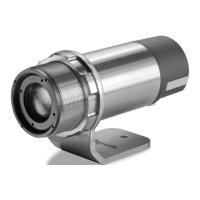Environment
Marathon MM Rev. D7 Jul 2017 25
5 Environment
Sensor location depends on the application. Before deciding on a location, you need to be aware of the
ambient temperature of the location, the atmospheric quality of the location, and the possible
electromagnetic interference in that location, according to the sections described above. If you plan to
use air purging, you need to have an air connection available. If you are installing the sensor in a
ThermoJacket accessory, you should use the appropriate mounting device. Also, wiring and conduit
runs must be considered, including computer wiring and connections, if used.
5.1 Ambient Temperature
The sensor is designed for measurements in ambient temperatures between 5°C and 65°C (41 to 149°F).
A water or air cooled housing is available as option to extend the operating range to 120°C (250°F) with
air cooling and to 175°C (350°F) with water cooling.
In ambient conditions up to 315°C (600°F), the ThermoJacket housing should be used. When using the
ThermoJacket, it is strongly recommended to use the supplied air purge to avoid condensation on the
lens.
5.2 Atmospheric Quality
If the lens gets too dirty, it cannot detect enough infrared energy to measure accurately. It is good
practice to always keep the lens clean. The air purge helps keep contaminants from building up on the
lens. If you use the air purge accessory, make sure a filtered air supply with clean dry air at the correct
air pressure is installed before proceeding with the sensor installation.
5.3 Electrical Interference
To minimize measurement errors due to electrical or electromagnetic interference or “noise” be aware
of the following:
Mount the electronics enclosure as far away as possible from potential sources of electrical
interference such as motorized equipment producing large step load changes.
Use shielded wire for all input and output connections.
Make sure the shield wire from the electronics to terminal block cable is earth grounded.
For additional protection, use conduit for the external connections. Solid conduit is better than
flexible conduit in high noise environments.
Do not run AC power in the same conduit as the sensor signal wiring.

